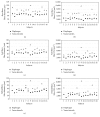Size and Proportions of Slow-Twitch and Fast-Twitch Muscle Fibers in Human Costal Diaphragm
- PMID: 27891518
- PMCID: PMC5116518
- DOI: 10.1155/2016/5946520
Size and Proportions of Slow-Twitch and Fast-Twitch Muscle Fibers in Human Costal Diaphragm
Abstract
Smaller diaphragmatic motor unit potentials (MUPs) compared to MUPs of limb muscles lead to the hypothesis that diaphragmatic muscle fibers, being the generators of MUPs, might be also smaller. We compared autopsy samples of costal diaphragm and vastus lateralis of healthy men with respect to fibers' size and expression of slow myosin heavy chain isoform (MyHC-1) and fast 2A isoform (MyHC-2A). Diaphragmatic fibers were smaller than fibers in vastus lateralis with regard to the mean minimal fiber diameter of slow-twitch (46.8 versus 72.2 μm, p < 0.001), fast-twitch (45.1 versus 62.4 μm, p < 0.001), and hybrid fibers (47.3 versus 65.0 μm, p < 0.01) as well as to the mean fiber cross-sectional areas of slow-twitch (2376.0 versus 5455.9 μm2, p < 0.001), fast-twitch (2258.7 versus 4189.7 μm2, p < 0.001), and hybrid fibers (2404.4 versus 4776.3 μm2, p < 0.01). The numerical proportion of slow-twitch fibers was higher (50.2 versus 36.3%, p < 0.01) in costal diaphragm and the numerical proportion of fast-twitch fibers (47.2 versus 58.7%, p < 0.01) was lower. The numerical proportion of hybrid fibers did not differ. Muscle fibers of costal diaphragm have specific characteristics which support increased resistance of diaphragm to fatigue.
Conflict of interest statement
The authors declare that there are no competing interests regarding the publication of this paper.
Figures



References
-
- Nandedkar S., Stalberg E., Sanders D. Quantitative EMG. In: Dumitru D., Amato A. A., Zwarts M., editors. Electrodiagnostic Medicine. 2nd. Philadelphia, Pa, USA: Hanley & Belfus; 2002. pp. 293–356.
-
- Mizuno M. Human respiratory muscles: fibre morphology and capillary supply. The European Respiratory Journal. 1991;4(5):587–601. - PubMed
MeSH terms
LinkOut - more resources
Full Text Sources
Other Literature Sources

